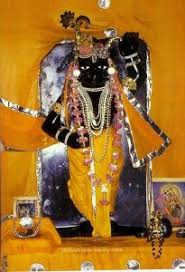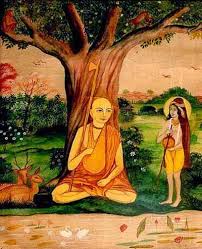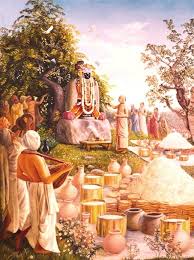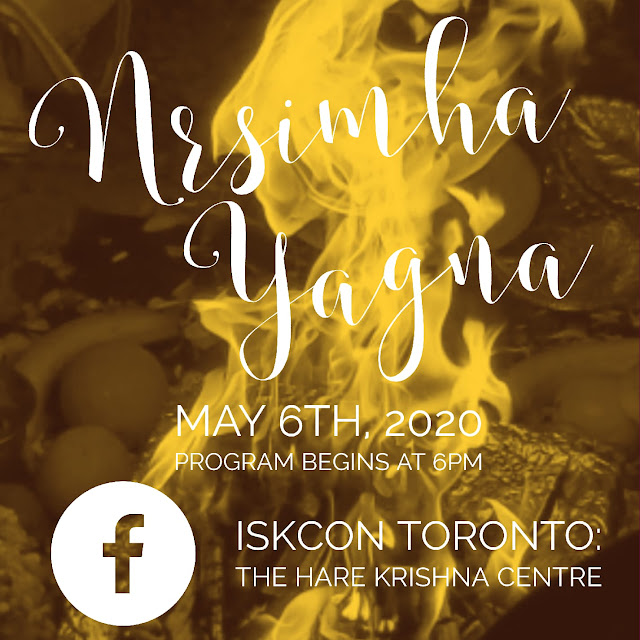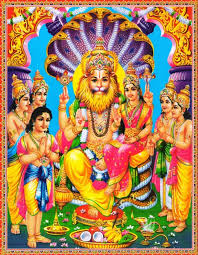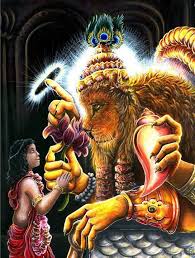 Today is an auspicious day in Krishna consciousness. Of course, every day is auspicious in Krishna consciousness. When we first arrived in India, in Bombay, Srila Prabhupada was invited to a program on the lawn of an aristocratic gentleman’s house. Most of us went ahead, and Srila Prabhupada followed with a few disciples. When we arrived, our hosts told us, “It is very auspicious that you have come today, because today is a holy day.” We had never heard of the holy day and were somewhat doubtful, so when Srila Prabhupada arrived I asked him, “Is it true that today is a holy day?” And Srila Prabhupada replied, “For us, every day is a holy day; we are Krishna’s servants.”
Today is an auspicious day in Krishna consciousness. Of course, every day is auspicious in Krishna consciousness. When we first arrived in India, in Bombay, Srila Prabhupada was invited to a program on the lawn of an aristocratic gentleman’s house. Most of us went ahead, and Srila Prabhupada followed with a few disciples. When we arrived, our hosts told us, “It is very auspicious that you have come today, because today is a holy day.” We had never heard of the holy day and were somewhat doubtful, so when Srila Prabhupada arrived I asked him, “Is it true that today is a holy day?” And Srila Prabhupada replied, “For us, every day is a holy day; we are Krishna’s servants.”
But today is a special holy day, because it is the disappearance day of one of Sri Chaitanya Mahaprabhu’s most confidential associates, Sri Ramananda Raya. Lord Chaitanya is Krishna Himself in the mood of Srimati Radharani, with Her bodily luster. Thus Lord Chaitanya is the combined form of Radha and Krishna (sri-krsna-caitanya radha-krsna nahe anya). And in Krishna lila Ramananda Raya is the gopi Visakha, one of the most confidential associates of both Srimati Radharani and Krishna. Spiritually, Visakha enjoyed a very intimate relationship with both Sri Krishna and Sri Radha.
In His later years, after He toured South India, Sri Chaitanya Mahaprabhu retired to Jagannatha Puri, and He experienced intense separation from Krishna, just like Srimati Radharani did after Krishna left Vrindavan. In that ecstatic mood of separation, He would confide in two very close associates—Sri Svarupa Damodara Gosvami, who in Krishna lila is the gopi Lalita, and Sri Ramananda Raya.
Today we shall read about the first meeting between Lord Chaitanya and Ramananda Raya. Lord Chaitanya was just beginning His tour of South India. When He arrived in Jagannatha Puri from Navadvipa after taking sannyasa, He went straight to the Jagannatha temple, and as soon as He saw Lord Jagannatha He fainted in ecstasy. He had been in the mood of searching for Krishna, and when He saw Jagannatha He felt that He had found His Lord, for whom He was searching, and fell into a deep ecstatic trance. Eventually, Sarvabhauma Bhattacharya, the chief appointed pandit in the court of the king, Maharaja Prataparudra, removed Sri Chaitanya to his home, and there they had some discussions. When Sri Chaitanya Mahaprabhu was about to depart on His tour of South India, Sarvabhauma Bhattacharya suggested that He meet and speak with Ramananda Raya, a most learned scholar and expert in the transcendental mellows of devotional service (bhakti-rasa).
Eventually Lord Chaitanya and Ramananda Raya met on the banks of the Godavari. Their meeting is vividly described in Sri Caitanya-caritamrta. After their initial meeting, they decided to meet again in the evening to discuss confidential topics of Krishna. Their discussions, called ramananda-samvada, contain all the truths of Gaudiya Vaishnava philosophy (siddhanta) and, with Lord Chaitanya’s instructions to Rupa Gosvami (rupa-siksa) and His instructions to Sanatana Gosvami (sanatana-siksa), are most important for understanding Vaishnava siddhanta, both rasa and tattva.
We shall read from Sri Caitanya-caritamrta, Madhya-lila, Chapter Eight: “Talks Between the Lord and Ramananda Raya.”
TEXT 1
sancarya ramabhidha-bhakta-meghe
sva-bhakti-siddhanta-cayamrtani
gaurabdhir etair amuna vitirnais
taj-jnatva-ratnalayatam prayati
TRANSLATION
Sri Caitanya Mahaprabhu, who is known as Gauranga, is the reservoir of all conclusive knowledge in devotional service. He empowered Sri Ramananda Raya, who may be likened to a cloud of devotional service. This cloud was filled with all the conclusive purports of devotional service and was empowered by the ocean to spread this water over the sea of Sri Caitanya Mahaprabhu Himself. Thus the ocean of Caitanya Mahaprabhu became filled with the jewels of the knowledge of pure devotional service.
COMMENT by Giriraj Swami
In this discussion between Ramananda Raya and Sri Chaitanya Mahaprabhu, Lord Chaitanya took the position of the student, or questioner, and Ramananda Raya was obliged to take the position of the teacher, or respondent. Ramananda Raya was hesitant, because apart from Chaitanya Mahaprabhu being the Supreme Personality of Godhead, in terms of the Vedic social system He was a brahman and a sannyasi, whereas Ramananda Raya, although a most learned scholar and exalted devotee, was a grihastha and was considered a sudra. So it was awkward for him to instruct Chaitanya Mahaprabhu, but Mahaprabhu told him, kiba vipra, kiba nyasi, sudra kene naya: it doesn’t matter whether one is a brahman, a sudra, a sannyasi, or whatever; yei krsna-tattva-vetta, sei ‘guru’ haya: anyone who knows the science of Krishna is a guru.
We shall read from the beginning of their discussion.
TEXT 56
namaskara kaila raya, prabhu kaila alingane
dui jane krsna-katha kaya rahah-sthane
TRANSLATION
Ramananda Raya approached Lord Sri Caitanya and offered his respectful obeisances, and the Lord embraced him. Then they began to discuss Krsna in a secluded place.
TEXT 57
prabhu kahe,—“pada sloka sadhyera nirnaya”
raya kahe,—“sva-dharmacarane visnu-bhakti haya”
TRANSLATION
Sri Caitanya Mahaprabhu ordered Ramananda Raya to recite a verse from the revealed scriptures concerning the ultimate goal of life.
Ramananda replied, “If one executes the prescribed duties of his social position, he awakens his original Krsna consciousness.
COMMENT
The original word in the text is sadhya—“the goal of life,” “that which is to be achieved.” Sadhana is the means by which we achieve the goal. Lord Chaitanya asked Ramananda Raya to say something about sadhya, the ultimate goal of life, and Ramananda Raya replied by citing different verses.
First Ramananda Raya quoted a verse from the Visnu Purana:
TEXT 58
varnasramacara-vata
purusena parah puman
visnur aradhyate pantha
nanyat tat-tosa-karanam
TRANSLATION
“‘The Supreme Personality of Godhead, Lord Visnu, is worshiped by the proper execution of prescribed duties in the system of varna and asrama. There is no other way to satisfy the Supreme Personality of Godhead. One must be situated in the institution of the four varnas and asramas.’”
PURPORT by Srila Prabhupada
This is a quotation from the Visnu Purana (3.8.9). As stated by Srila Bhaktivinoda Thakura in his Amrta-pravaha-bhasya, “The purport is that one can realize life’s perfection simply by satisfying the Supreme Personality of Godhead.” This is also confirmed in Srimad-Bhagavatam (1.2.13):
atah pumbhir dvija-srestha
varnasrama-vibhagasah
svanusthitasya dharmasya
samsiddhir hari-tosanam
“O best among the twice-born, it is therefore concluded that the highest perfection one can achieve by discharging the duties prescribed for one’s own occupation according to caste divisions and orders of life is to please the Personality of Godhead.”
COMMENT
The goal of all of our activities should be to please Krishna, and the verse quoted by Ramananda Raya recommends executing one’s duties according to one’s varna and ashrama. Prabhupada often said that varnashrama-dharma is the beginning of human life. Dharmena hinah pasubhih samanah: without dharma, men are on the level of animals. Why? Because dharma, religious principles, or varnashrama-dharma, occupational duties, regulate the activities of the living being. Without being regulated, a person is just like an animal. An animal eats whatever he wants, sleeps whenever he wants for as long as he can; has sex with whomever he wants whenever he can; and defends himself, arranges some shelter for himself, however he can. Even if a man engages his superior, human intelligence in these same activities, he is no better than an animal.
The human being may eat on a nice plate on a nice table, and the animal may eat on the floor of the jungle, but the animal enjoys his eating as much as the human being enjoys eating. The human may sleep on a nice mattress in a nice house, and the animal may sleep on the ground, but when asleep the animal doesn’t know he is sleeping on the ground, or the human that he is sleeping on a mattress. Sleeping is the same; in fact, the human’s sleep might be more disturbed than the animal’s, because he has so many worries and anxieties and causes of depression. And the animal might defend himself with his teeth and claws, and the human with sophisticated weapons of mass destruction, but it is the same principle—defending.
Eating, sleeping, mating, and defending are common to human beings and animals. What distinguishes a human from an animal is dharma, following religious principles to become God conscious. Otherwise, there is no difference.
ahara-nidra-bhaya-maithunam ca
samanyam etat pasubhir naranam
dharmo hi tesam adhiko viseso
dharmena hinah pasubhih samanah
“Both animals and men share the activities of eating, sleeping, mating, and defending. But the special property of the humans is that they are able to engage in spiritual life. Therefore without spiritual life, humans are on the level of animals.” (Hitopadesa)
Now, one might question, “You mean to say that all the big leaders of the world—the presidents and prime ministers and scientists and Nobel Prize laureates—if they are not Krishna conscious, God conscious, they are no better than animals?” Srimad-Bhagavatam says that they are just bigger animals. In the jungle the small animals all fear the big animals—respect the big animals—and the Bhagavatam says that those who never engage in krsna-katha, who never hear the glories of the Lord, are just small animals who praise the bigger ones.
sva-vid-varahostra-kharaih
samstutah purusah pasuh
na yat-karna-pathopeto
jatu nama gadagrajah
“Men who are like dogs, hogs, camels, and asses praise those men who never listen to the transcendental pastimes of Lord Sri Krsna, the deliverer from evils.” (SB 2.3.19)
So, dharma is the beginning of human life, and one should execute one’s duties in varnashrama-dharma for the pleasure of the Supreme Lord, Vishnu. By that process one advances to the goal of life.
Here, Ramananda Raya and Sri Chaitanya Mahaprabhu are discussing krsna-katha. And after hearing this verse, what does Sri Chaitanya Mahaprabhu say?
TEXT 59
prabhu kahe,—“eho bahya, age kaha ara”
raya kahe, “krsne karmarpana—sarva-sadhya-sara”
TRANSLATION
The Lord replied, “This is external. You had better tell Me of some other means.”
Ramananda replied, “To offer the results of one’s activities to Krsna is the essence of all perfection.”
COMMENT
Varnashrama-dharma is required, but following the regulations of varnashrama-dharma does not necessarily mean that one will be Krishna conscious. One can follow the rules and regulations, but if one is not in the mood of offering the results of one’s work to Krishna, he will not be Krishna conscious—directly Krishna conscious.
Ramananda Raya next quoted a verse from the Bhagavad-gita (9.27):
TEXT 60
yat karosi yad asnasi
yaj juhosi dadasi yat
yat tapasyasi kaunteya
tat kurusva mad-arpanam
TRANSLATION
“‘O son of Kunti, all that you do, all that you eat, all that you offer and give away, as well as all austerities that you may perform, should be done as an offering to Me.’”
COMMENT
Here we are going a step further. One still works according to one’s position in the varnashrama system, but one offers the results of one’s work to Krishna, as Krishna advises in the Bhagavad-gita. That is definitely a further development. And what does Sri Chaitanya Mahaprabhu say?
TEXT 61
prabhu kahe,—“eho bahya, age kaha ara”
raya kahe,—“svadharma-tyaga, ei sadhya-sara”
TRANSLATION
“This is also external,” Sri Caitanya Mahaprabhu said. “Please proceed and speak further on this matter.”
Ramananda Raya replied, “To give up one’s occupational duties in the varnasrama system is the essence of perfection.”
COMMENT
Ramananda Raya cited two verses in support of this proposal, and Sri Chaitanya Mahaprabhu responded:
TEXT 64
prabhu kahe,—“eho bahya, age kaha ara”
raya kahe, “jnana-misra bhakti—sadhya-sara”
TRANSLATION
After hearing Ramananda Raya speak in this way, Lord Sri Caitanya Mahaprabhu said, “Go ahead and say something more.”
Ramananda Raya then replied, “Devotional service mixed with empiric knowledge is the essence of perfection.”
COMMENT
To offer the fruits of one’s work to Krishna is good, but even then one might be attached to one’s work. To give up one’s position in varnashrama-dharma is better, because it shows more detachment. But even if one has detachment, one may not have knowledge. So Ramananda Raya went further, including knowledge as part of the means, with reference to a verse from the Bhagavad-gita (18.54).
And what did Lord Chaitanya say? “Eho bahya, age kaha ara.” He wanted Ramananda Raya to go further. And Ramananda Raya responded.
TEXT 66
prabhu kahe, “eho bahya, age kaha ara”
raya kahe,—“jnana-sunya bhakti—sadhya-sara”
TRANSLATION
After hearing this, the Lord, as usual, rejected it, . . .
COMMENT
He rejected devotional service mixed with empiric knowledge (jnana-misra bhakti).
TRANSLATION (continued)
. . . considering it to be external devotional service mixed with knowledge. He again asked Ramananda Raya to speak further, and Ramananda Raya replied, “Pure devotional service without any touch of speculative knowledge is the essence of perfection.”
COMMENT
Ramananda Raya then quoted an important verse from the Tenth Canto of Srimad-Bhagavatam (10.14.3):
TEXT 67
jnane prayasam udapasya namanta eva
jivanti san-mukharitam bhavadiya-vartam
sthane sthitah sruti-gatam tanu-van-manobhir
ye prayaso ’jita jito ’py asi tais tri-lokyam
TRANSLATION
Ramananda Raya continued, “[Lord Brahma said:] ‘My dear Lord, those devotees who have thrown away the impersonal conception of the Absolute Truth and have therefore abandoned discussing empiric philosophical truths should hear from self-realized devotees about Your holy name, form, pastimes, and qualities. They should follow the principles of devotional service and remain free from illicit sex, gambling, intoxication, and animal slaughter. Surrendering themselves fully with body, words, and mind, they can live in any asrama or social status. Indeed, You are conquered by such persons, although You are always unconquerable.’”
COMMENT
Then Lord Chaitanya said, eho haya, “This is it!”—not eho bahya, “This is external.” But even then He added, age kaha ara: “Please speak further.”
TEXT 68
prabhu kahe, “eho haya, age kaha ara”
raya kahe, “prema-bhakti—sarva-sadhya-sara”
TRANSLATION
At this point, Sri Caitanya Mahaprabhu replied, “This is all right, but still you can speak more on the subject.”
Ramananda Raya then replied, “Ecstatic love for the Supreme Personality of Godhead is the essence of all perfection.”
COMMENT
In the purport Srila Prabhupada says, “In his Amrta-pravaha-bhasya, Srila Bhaktivinoda Thakura summarizes the conversation up to this point, where Lord Chaitanya Mahaprabhu says to Ramananda Raya, eho haya, age kaha ara: ‘This is the process accepted in devotional service, but there is something more than this. Therefore please explain what is beyond.’”
The point is that although the verse from Srimad-Bhagavatam describes the process of pure devotional service, in the neophyte stage devotional activities may sometimes appear impure; there may appear to be some material taint in one’s devotional activities. Therefore, although Lord Chaitanya said, “You have come to this point of pure devotional service, which I accept as the goal of life and simultaneously the means to achieve the goal,” He also said, “Go further,” because He wanted to make sure that we come to the goal, prema-bhakti.
Srimad-Bhagavatam (11.3.31) says, bhaktya sanjataya bhaktya: bhakti comes from bhakti. We have come to the point of bhakti, pure bhakti, but bhaktya sanjataya bhaktya—prema-bhakti, or sadhya-bhakti, comes from sadhana-bhakti. Sadhana-bhakti will lead to the goal, but one must stick to the process. If one does stick to the process, he will reach the goal, prema-bhakti.
Now we shall discuss the process of pure devotional service described in the verse cited by Sri Ramananda Raya, because that is a process that each and every one of us can and should follow. It is feasible for every one of us. We shall discuss each word, because each word is important.
Jnane here means “for speculative knowledge.” Speculative knowledge almost always leads to an imperfect, impersonal conclusion. Prayasam means “unnecessary endeavor”—it is unnecessary. And udapasya means “giving up completely.” The endeavor for speculative knowledge has absolutely no value for a devotee and should be given up completely. Namantah. In his synonyms, Srila Prabhupada writes, “completely surrendering.” More literally, namanta is translated as “offering obeisances.” Obeisances are an indication of submission and surrender. Once, Srila Prabhupada paraphrased these words: “You should give up the bad habit of speculation and just become submissive.”
San-mukharitam bhavadiya-vartam. Bhavadiya-vartam means “discussions related to You [Krishna],” and san-mukharitam means “from the mouths of pure devotees [sat].” We should hear the messages of Godhead from the mouths of truthful devotees, not from professional reciters.
In India there are many professional reciters, and some tour. Although they may be very popular, hearing from them will not help. People go to them to be entertained, or they may feel that they are performing some pious activity. But what result do they want from such piety? Often they just want to be happy in the material world.
Srila Prabhupada spoke of one Bhagavata reciter who would tell his audience, “Srimad-Bhagavatam teaches that you should be happy in family life.” Now, the Bhagavatam is filled with stories of devotees who left their families to realize God, beginning with the speaker of the Bhagavatam, Sukadeva Gosvami. He did not remain at home long enough even to have his sacred-thread or other ceremonies. He just walked out of the house, and his father, Srila Vyasadeva, the literary incarnation of Godhead, went running after him into the forest, calling for him, but all he heard was the echoing of his voice in the trees.
yam pravrajantam anupetam apeta-krtyam
dvaipayano viraha-katara ajuhava
putreti tan-mayataya taravo ’bhinedus
tam sarva-bhuta-hrdayam munim anato ’smi
“Let me offer my respectful obeisances unto that great sage [Sukadeva Gosvami] who can enter the hearts of all. When he went away to take up the renounced order of life [sannyasa], leaving home without undergoing reformation by the sacred thread or the ceremonies observed by the higher castes, his father, Vyasadeva, fearing separation from him, cried out, ‘O my son!’ Indeed, only the trees, which were absorbed in the same feelings of separation, echoed in response to the begrieved father.” (SB 1.2.2)
Sukadeva Gosvami was gone. From the very beginning of Srimad-Bhagavatam we hear the histories of great devotees who left hearth and home to realize God. All five Pandavas left for the Himalayas. And Maharaja Pariksit gave up his family and kingdom to sit on the bank of the Ganges and hear Srimad-Bhagavatam.
Why did the professional reciter claim that the Bhagavatam teaches that you should remain happy in family life? Because, Prabhupada said, he wanted to get donations from the householders, so he wanted to say something that would please them. Sadhu means “to cut.” We have to hear from the mouths of sadhus (san-mukharitam). Then it will be effective. Srila Prabhupada said—and I saw it myself when I visited a large Bhagavata-saptaha—that immediately after the recitation, everything remains as it was. People do not change. After the recitation people light up their cigarettes and talk about what a nice katha they heard. This kind of katha—Bhagavata-saptaha or whatever—will not help. Sanatana Gosvami says, avaisnava-mukhodgirnam putam hari-kathamrtam sravanam naiva kartavyam: one should not hear talks about Krishna from a non-Vaishnava. San-mukharitam—one should hear from pure devotees, self-realized souls.
Sthane sthitah means “remaining in their position.” It doesn’t matter if one is a grihastha. One can remain a grihastha—he need not become a sannyasi. That is not the point. One can remain in his position in the varnashrama system (although in natural course one may change his position), because pure devotional service is transcendental. Anyabhilasita-sunyam jnana-karmady-anavrtam. It is not limited by any material condition; it cannot be covered by karma or jnana or anything else. It is transcendental. So you can stay in your position, but you must follow the process described here.
In his translation Srila Prabhupada writes, “You should completely follow the principles of devotional service and remain free from illicit sex, gambling, intoxication, and animal slaughter.” Now, we don’t find these words in the Sanskrit. There are different types of translation, which have different names in Sanskrit. In one kind of translation one puts a bit of the purport into the translation, and that is what Srila Prabhupada did here. And I really appreciate it, because one can take this phrase sthane sthitah, “you remain in your position,” to mean, “Oh, I am fine as I am. I was getting worried for a while, but I can stay in my position and do everything the same.” Perhaps anticipating such a response from some readers, Srila Prabhupada qualified the phrase right in the translation. He did not take any chances that a reader would harbor any misconceptions going into the purport, but in the translation itself he says, “Yes, you can remain in your position, but you must follow the process of devotional service and refrain from illicit sex; gambling (and speculating); intoxicants, including tea, coffee, and cigarettes; and eating meat, fish, or eggs.”
If you do that, you can stay in your position and become Krishna conscious. That is the beauty of Chaitanya Mahaprabhu’s movement, the beauty of the bhakti cult, that one can remain in one’s position and execute devotional service in Krishna consciousness. A grihastha can become a pure devotee, and a sannyasi can become a pure devotee. Anyone can become a pure devotee if he or she follows the process. And anyone can follow. So it is very easy. One can remain in his or her position and simply follow. Jivanti means that a devotee who always hears about Krishna will go back home, back to Godhead. He or she must simply follow the regulative principles and remain alive in Krishna consciousness by hearing and chanting about Krishna.
Tanu-van-manobhih. Tanu means “body,” vak means “words,” and mana means “mind.” Our acharyas have explained how these words can relate to other words in the text. The basic meaning is that one should surrender fully, with body, words, and mind, to the topics of Krishna spoken by self-realized souls. Srila Visvanatha Cakravarti says that one should offer all respects and obeisances (namantah) with one’s body, words, and mind. With one’s body one can offer obeisances to the Bhagavatam, to the speaker of the Bhagavatam, and to the holy place where the Bhagavatam is recited. With one’s words one can glorify the Bhagavatam and the speakers of the Bhagavatam, and one can repeat the message and narrations of Krishna. And with one’s mind one can feel reverence for and take pleasure in the topics of Krishna, and one can remember the instructions and pastimes of Krishna. Thus one can be fully engaged with one’s body, words, and mind—not that with our body we sit in the krsna-katha but with our mind we are somewhere else, calculating how much money we have in the bank and if we have enough to make the next payments. It is possible that one’s body could be in the krsna-katha but one’s words or mind could be somewhere else. But if we always engage everything (tanu-van-manobhih), our whole being, in krsna-katha, in Krishna consciousness, that is pure devotional service.
And what is the result? Ye prayaso ’jita jito ’py asi tais tri-lokyam. One of Krishna’s names is Ajita, “unconquerable.” Even though Krishna cannot be conquered by any means, He can be conquered by pure devotees who follow this process. That is the conclusion. In other words, they will come to the stage of prema-bhakti, because Krishna is conquered only by prema, the pure love of His devotees.
Srila Sanatana Gosvami explains tanu-van-manobhih (“by body, words, and mind”) in relation to conquering Krishna, who is unconquerable, in three ways. He says that nondevotees can never conquer Krishna. They cannot conquer Him by their physical strength (like Hiranyakasipu), by their verbal expertise, or by their mental power. Despite all their endeavors, the Absolute Truth remains beyond their grasp. But devotees, by engaging fully in devotional service, become perfect in Krishna consciousness, and thus they can conquer Him. Then they can touch His lotus feet with their hands, they can call Him to come with their words, and simply by thinking of Him they can gain His direct audience within their minds.
His Holiness Rtadhvaja Swami told me about a dream he had in which he was chanting Hare Krishna, and Krishna appeared. Scripture tells us, nama cintamanih krsnas caitanya-rasa-vigrahah purnah suddho nitya-mukto ’bhinnatvan nama-naminoh—the name of Krishna and Krishna Himself are the same. So, in his dream he was chanting Hare Krishna and Krishna appeared. And in his dream he thought, “Oh, it’s true!” This is an example of how Krishna can be conquered by one’s words. If we chant Hare Krishna purely, Krishna comes. He appears. And the pure devotee, the self-realized soul, if he just thinks of Krishna, Krishna appears in his mind—or in person. He remains by the side of His devotee.
Sanatana Gosvami further explains these words in relation to Krishna, that Krishna’s body is conquered because He always remains by the side of His pure devotee, His words are conquered because He always sings the praises of His devotees, and His mind is conquered because He always thinks of His pure devotees. One can completely conquer Krishna by pure devotional service.
In the discussion between Lord Chaitanya and Ramananda Raya, this verse from Srimad-Bhagavatam marks the beginning of pure devotional service. But the discussion goes further. Lord Chaitanya keeps saying, age kaha ara: “Speak more; go further.” Then we come to vaidhi-bhakti and raganuga-bhakti, and then to santa-rasa, dasya-rasa, sakhya-rasa, vatsalya-rasa, and madhurya-rasa. In madhurya-rasa there are many gopis, and among them Srimati Radharani is the foremost. And Srimati Radharani Herself has various developments of ecstatic feelings, culminating in prema-vilasa-vivarta, the height of ecstatic love in separation. When Ramananda Raya came to that point, Chaitanya Mahaprabhu covered his mouth with His hand and said, “This is the limit of the goal of life. Only by your mercy have I come to understand it.”
At the end of their discussions, Ramananda Raya said to Lord Chaitanya, “At first I saw You as a sannyasi, but now I see You as Syamasundara, the cowherd boy, and now I see You with a golden luster. Please explain the reason.” Sri Chaitanya Mahaprabhu was playing the part of a devotee, and for a devotee to be addressed as Krishna or even considered on the same level as Krishna is anathema. So Chaitanya Mahaprabhu replied, “You are an advanced devotee, and an advanced devotee—a maha-bhagavata—sees Krishna everywhere.”
sthavara-jangama dekhe, na dekhe tara murti
sarvatra haya nija ista-deva-sphurti
“The maha-bhagavata, the advanced devotee, certainly sees everything mobile and immobile, but he does not exactly see their forms. Rather, everywhere he immediately sees manifest the form of the Supreme Lord.” (Cc Madhya 8.274)
Then Mahaprabhu quoted a verse from Srimad-Bhagavatam that describes the maha-bhagavata, that he doesn’t exactly see the forms of the material world but sees Krishna manifest everywhere.
sarva-bhutesu yah pasyed
bhagavad-bhavam atmanah
bhutani bhagavaty atmany
esa bhagavatottamah
“A person advanced in devotional service sees within everything the soul of souls, the Supreme Personality of Godhead, Sri Krsna. Consequently he always sees the form of the Supreme Personality of Godhead as the cause of all causes and understands that all things are situated in Him.” (SB 11.2.45, quoted as Cc Madhya 8.275)
Ramananda Raya replied, “Please give up these serious talks. Do not try to conceal Your real form. I know who You are.” Then, out of His causeless mercy, Sri Chaitanya Mahaprabhu revealed His combined form of Radha and Krishna (rasaraja and mahabhava). We have a relief on the wall of the temple here that shows Ramananda Raya witnessing Sri Chaitanya Mahaprabhu manifesting His form as Radha and Krishna. And Ramananda Raya became overwhelmed with transcendental bliss. There are some esoteric explanations of this pastime in which Chaitanya Mahaprabhu revealed the confidential truth of His identity—sri-krsna-caitanya radha-krsna nahe anya. On occasion He would manifest Himself, but He would always say, “Do not disclose this fact to anyone,” because He was playing the part of a devotee and wanted to maintain His role as a devotee, to fulfill His purpose to show by example how to be a devotee and practice pure devotional service.
Especially in Kali-yuga, people are so fallen and prone to become imitation gods or accept imitation gods that the Lord, as Krishna Chaitanya Mahaprabhu, hid His identity. He was a channa-avatara, a “concealed incarnation,” as mentioned in Srimad-Bhagavatam.
Srila Prabhupada told the story of a man in Calcutta who could imitate the barking of different types of dogs. He would hold programs in halls and sell tickets, and people would come to hear his demonstrations. Srila Prabhupada remarked that people would pay money to hear the imitation dog but that real dogs were barking in the street yet no one paid them heed. Similarly, the real God—Krishna—is there, but nobody cares. Yet if some imitation God comes, they flock. Get on a plane and go. Jump in a car and go. That is Kali-yuga.
That is why Chaitanya Mahaprabhu’s identity as Radha and Krishna was revealed only to certain select devotees such as Ramananda Raya, and it is by their mercy and by the mercy of Srila Krishnadasa Kaviraja Gosvami, who wrote Sri Caitanya-caritamrta, and by the mercy of Srila Prabhupada, who translated and presented it to us in a most appropriate way, through parampara, that we are able to enter into these transcendental mysteries and have the opportunity to realize the most confidential service of Radha and Krishna—by their mercy, following in their footsteps.
[A talk by Giriraj Swami on Sri Ramananda Raya’s disappearance day, May 25, 2008, Houston]














